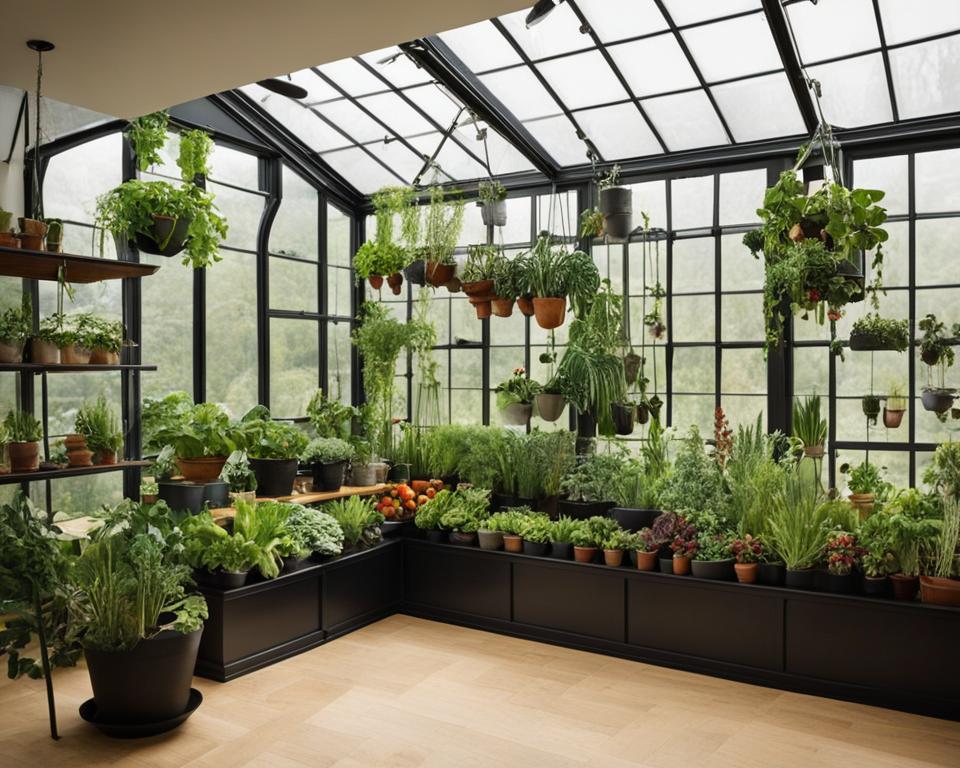Greenhouse gardening has long been a treasured solution for year-round plant cultivation, but as urban space becomes increasingly scarce, vertical gardening techniques have risen to revolutionize the way we grow. If you’re navigating the world of indoor gardening or finding new strategies for urban gardening, you may be intrigued by the potential of vertical greenhouse gardening. It’s the symbiosis of innovation and tradition, promising a bountiful, lush garden in even the most space-constrained environments. Get ready to learn how you can harness the power of verticality to turn your greenhouse into a vibrant, thriving oasis.
Imagine walls adorned with verdant herbs, rows of crisp leafy greens, and clusters of ripe tomatoes—all reaching upwards towards the nourishing light. Within the controlled sanctuary of a greenhouse, vertical gardening presents a sustainable approach to plant care, offering numerous benefits over traditional methods. Let’s delve into these methods and uncover the secrets to amplifying your garden’s productivity, sustainability, and aesthetic appeal. Embrace the art of stacking, hanging, and trellising—a fresh, flourishing garden is within your vertical reach.
Key Takeaways
- Vertical gardening ensures efficient space usage and bountiful growth in urban areas.
- Greenhouse gardening persists as a reliable method for year-round plant cultivation.
- Indoor gardening gains a productive edge with vertical design innovations.
- Adopting vertical systems can transform limited areas into lush, green environments.
- Urban gardening leaps forward with vertical techniques, optimizing minimal spaces for maximum yield.
The Innovative World of Vertical Greenhouse Gardening
In an era where urban land is as valuable as gold, vertical greenhouse gardening emerges as a silver bullet for green-thumbed city dwellers. This method transforms the very essence of horticulture, taking the idyllic pastime of tending to garden beds and elevating it to new heights—literally.
Defining Vertical Greenhouse Gardening
At its core, vertical greenhouse gardening entails growing plants in a stacked arrangement within a controlled, greenhouse environment. Such innovative practices are not just a trend but a practical solution for small space gardening. Utilizing advanced techniques like hydroponics, your plants thrive without the need for traditional soil beds, their roots nourished directly by nutrient-rich solutions.
Impact on Urban Farming and Sustainability
Urban landscapes are transformed into lush, productive gardens with vertical greenhouse systems that embody the very spirit of sustainable gardening. By stacking the odds in favor of plant productivity, these gardens utilize minimal ground space and conserve water, setting the stage for agrarian efficiency in the heart of the concrete jungle.
- Sustainable water usage: Significantly less water required than traditional farming methods
- Year-round crop production: Seasonal changes no longer dictate harvests
- Space optimization: Vertical structures drastically increase planting area
Let’s dive deeper into the advantages of vertical greenhouse gardening with a comparative table that contrasts it with traditional farming methods.
| Parameter | Vertical Greenhouse Gardening | Traditional Farming |
|---|---|---|
| Space Efficiency | Highly efficient (vertical space) | Dependent on horizontal land area |
| Water Usage | Up to 90% reduction in water use | High water consumption |
| Crop Yield | Increased yield due to controlled conditions | Variable yield, weather-dependent |
| Seasonal Limitations | Limited effect due to controlled environment | Significant impact on growing seasons |
| Sustainability | Supports sustainable practices | Often requires pesticides and herbicides |
As we delve into the specifics of what makes vertical greenhouse gardening so revolutionary, we find that it is a harbinger for environmentally conscious production, a beacon for small space gardening, and a pioneer in feeding the urban populace.
Maximizing Growth in Limited Spaces
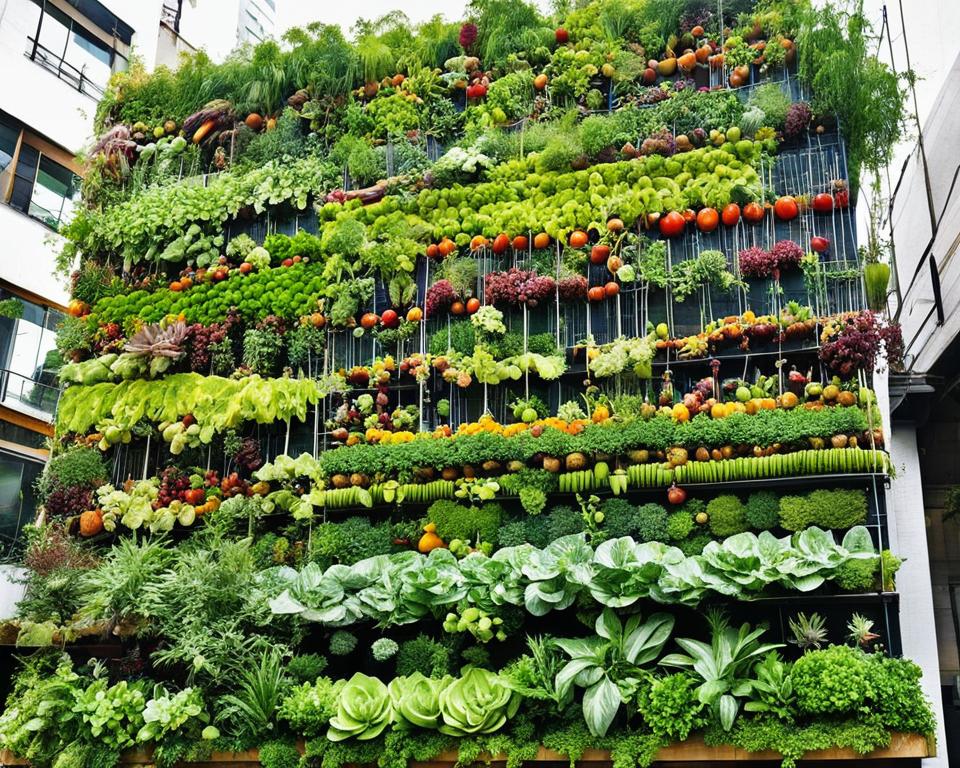
For gardeners challenged by the confines of tiny apartments or constrained urban plots, small space gardening emerges as an innovative solution. Leveraging the vertical dimension, these gardening hacks enable you to cultivate an array of plants where ground space is at a premium. You’ll find that vertical gardening isn’t just a practical response to spatial limits—it’s a creative endeavor that transforms your living area into a vibrant, leafy retreat.
Vertical trellises and hanging baskets are among the resourceful methods to expand your growth area upwards rather than outwards. This strategy allows for a more diverse range of edible and ornamental plants to thrive above the square footage that would traditionally limit a gardener’s ambition. Below is a table outlining some effective small space gardening structures, each providing unique advantages for the urban horticulturist.
| Structure Type | Advantages | Ideal Plants |
|---|---|---|
| Vertical Trellises | Maximizes vertical space, supports vining plants, easy to install | Tomatoes, Beans, Peas |
| Hanging Baskets | Utilizes overhead space, portable, visually striking | Cherry Tomatoes, Strawberries, Various Herbs |
| Wall Planters | Transforms walls into green spaces, modular, suitable for indoor/outdoor | Succulents, Ferns, Small Flowers |
| Container Systems | Flexible layout, scalable, controls soil quality | Leafy Greens, Peppers, Eggplants |
Whether your interest lies in a lush edible garden or a tapestry of blooming flowers, the key to triumph in small space gardening is selecting the right combination of structures that align with your living environment and gardening goals. Adopting these gardening hacks can lead to a productive and delightful garden oasis, proving that limited space need not curb your horticultural aspirations.
The Environmental Benefits of Vertical Gardens
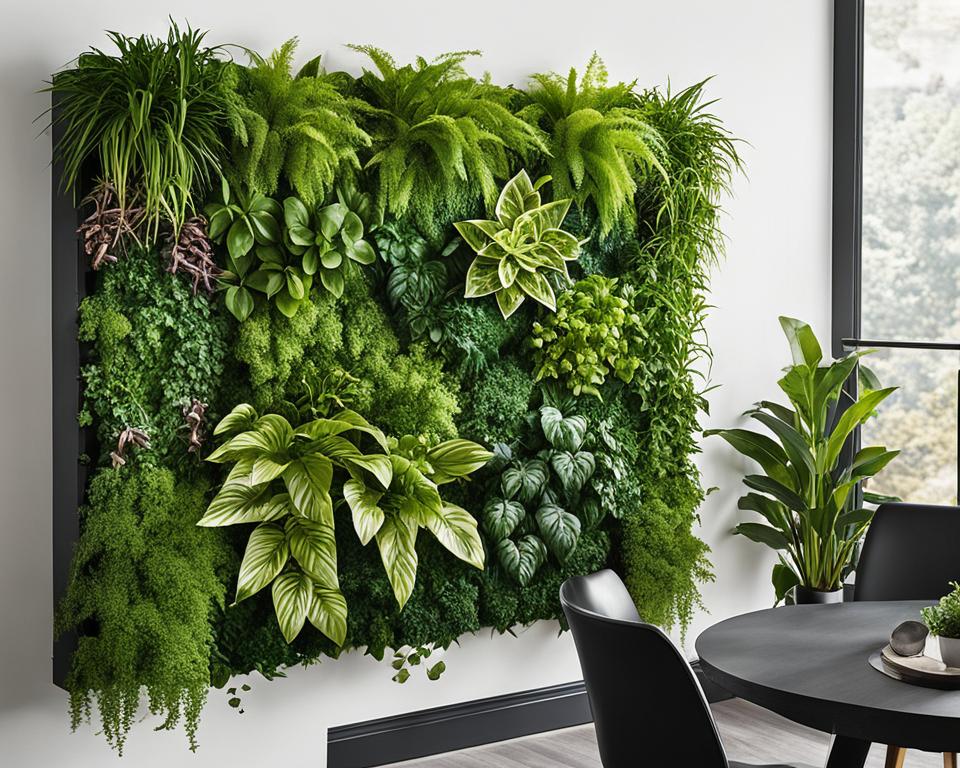
As urban landscapes transform, sustainable gardening practices are coming to the forefront, with vertical gardens playing a pivotal role. Not only do vertical gardens present a vision of eco-friendly growth within compact spaces, but they also offer a range of environmental benefits. By focusing on local food production and reducing the need to transport goods, these dynamic green spaces are carving a path toward greener cities and a healthier planet.
Reducing the Carbon Footprint with Local Production
One of the most powerful impacts of embracing vertical gardening within greenhouses is the drastic reduction in the carbon footprint associated with long-distance produce transportation. By cultivating your own bountiful harvest in the heart of the city, traveling expenses and emissions are significantly trimmed, bolstering local production and food security.
Conserving Water with Advanced Irrigation Techniques
Hydroponic gardening systems, often a component of vertical gardens, have revolutionized the way we use water in agriculture. Through meticulously designed irrigation systems, such as drip and closed-cycle watering, these gardens ensure that every drop of water is used effectively, setting a new standard for water conservation efforts.
Advanced irrigation could save up to 98% more water than conventional gardening methods.
Creating Pesticide-Free Ecosystems
The protective environment of a greenhouse paired with the vertical structure largely shields plants from pests and diseases. This controlled setting fosters organic gardening, as it minimizes, and in some cases entirely removes, the need for harmful chemical pesticides. As a result, you enjoy healthier, pure produce straight from your vertical oasis.
- Improves urban air quality
- Enhances biodiversity in urban areas
- Reduces urban heat island effect
| Sustainable Practice | Benefit |
|---|---|
| Localized Food Production | Decreases carbon emissions from transport |
| Advanced Irrigation | Conserves up to 98% of water |
| Organic Cultivation | Eliminates chemical pesticide use |
Choosing the Right Crops for Your Vertical Greenhouse
Embarking on vertical greenhouse gardening is an exciting journey that transforms the way you utilize space and cultivate crops. To enhance your venture into organic gardening, selecting the right crops is pivotal for success. Your vertical garden is not just a striking visual accent; it’s a living, breathing ecosystem that flourishes with the correct plant choices.
Imagine your vertical greenhouse as a stage, where each plant plays a vital role in the symphony of growth. Some plants are natural stars in a vertical setup, reveling in the upwards climb and basking in ample light and breeze. Others might require careful consideration regarding their growth habits and the support they will need.
- Tomatoes: Aspiring vertical gardeners will find tomatoes to be a perfect match for their garden walls. Their tendency to grow upwards makes them a prime candidate for vertical training systems.
- Cucumbers: Cucumber vines gracefully scale the vertical confines, producing bountiful crops when supported by trellises or netting.
- Peas: With their slender tendrils, peas easily cling to any vertical structure, allowing for convenient harvesting at eye level.
- Strawberries: Vertical tiered planters are excellent for strawberries, keeping them off the ground and within easy reach for plucking.
- Herbs: Aromatic herbs like basil, mint, and parsley thrive vertically, ensuring fresh flavors are always just an arm’s stretch away.
- Leafy Greens: Spinach, lettuce, and swiss chard excel in vertical gardens, requiring minimal space to produce substantial yields.
As you plan your organic vertical garden, consider how each plant’s nature complements the vertical growth model. Look at the conditions your greenhouse provides and match the crops accordingly. In the end, your savvy selections will result in a thriving green space — a testament to the harmony between vertical design and botanical potential.
Organic gardening cultivators often focus on not just the yield but the quality of their produce. Consequently, your organic vertical greenhouse can be more than a source of sustenance; it can be a space of verdant vitality and vigor.
Crafting the Ideal Vertical Garden Structure
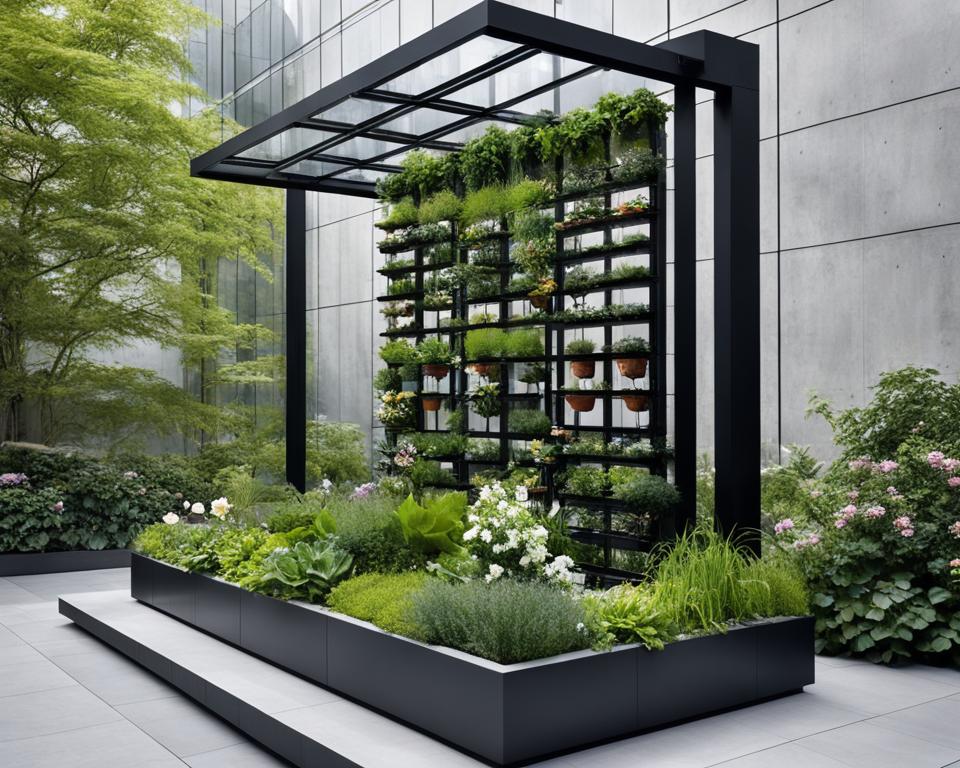
Embarking on the journey of creating a vibrant and productive vertical garden within your greenhouse is an enriching endeavor. Getting it right involves more than just selecting your favorite plants; it requires a keen eye for materials and a thoughtful approach to design that promotes the longevity and health of your green oasis.
Selecting Materials for Durability and Aesthetics
Choosing materials that can withstand the rigors of plant growth while adding a visual appeal is crucial for the success of your vertical and greenhouse gardening projects. Look for options like galvanized steel, cedarwood, or high-quality plastics that are not only robust but also enhance the aesthetic value of your space. Here’s a glance at some of your best material choices:
| Material Type | Pros | Cons |
|---|---|---|
| Galvanized Steel | Durable, resists rust, supports heavy loads | Can be costly, less eco-friendly |
| Cedarwood | Naturally rot-resistant, visually appealing | Requires regular maintenance |
| High-quality Plastics | Lightweight, weather-resistant, affordable | Not biodegradable, varies in UV stability |
Integrating these materials into your sustainable gardening practice not only ensures a resilient structure but also contributes to the overall health and productivity of your garden.
Design Considerations for Optimal Plant Health
The right design choices can have a significant impact on the success of growing healthy plants in a limited space. Designing your vertical garden to maximize light penetration and facilitate air flow is paramount. A well-planned garden structure should:
- Allow even light distribution to all plants
- Enable proper air circulation to prevent diseases
- Provide easy access for maintenance and harvesting
Moreover, incorporating hydroponic setups or drip irrigation systems can greatly reduce water usage while ensuring that your plants receive the required nutrients efficiently.
In the end, your vertical garden’s resilient structure and thoughtful design not only epitomize the essence of sustainable gardening but also stand as a testament to your commitment to green living.
Integrating Hydroponic Systems in Vertical Gardening
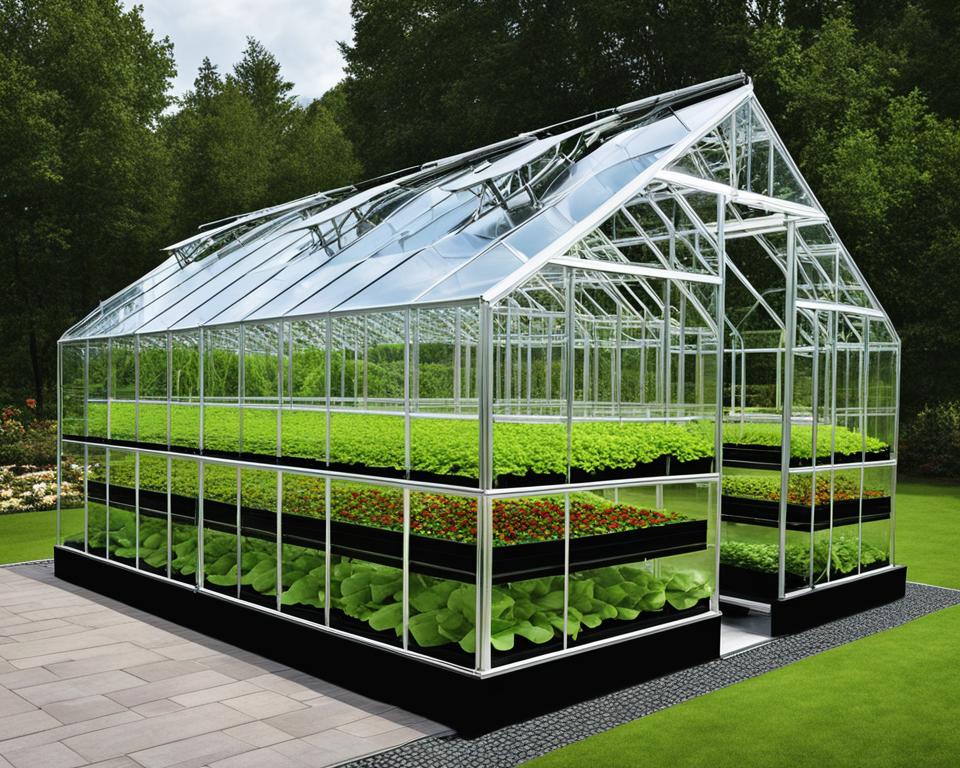
The advent of hydroponics has revolutionized the way we approach vertical greenhouse gardening. By eliminating the need for soil, hydroponic systems offer an efficient and space-saving method to cultivate a variety of plants, harnessing the power of nutrient solutions. As urban agriculture continues to expand, so does the integration of hydroponic methods within vertical gardening spaces, fostering a new wave of sustainable farming practices.
The Basics of Hydroponic Farming
Hydroponic gardening operates on a simple yet innovative premise—growing plants in a water-based, nutrient-rich solution. It’s a soilless form of agriculture where you can observe faster plant growth and greater yields. The essence of hydroponic systems lies in their ability to provide consistent and balanced nutrition to plants, resulting in higher productivity within your vertical greenhouse.
Choosing Between Hydroponics, Aquaponics, and Aeroponics
Deciding which soilless technique best suits your vertical greenhouse gardening needs is paramount. With hydroponics, you embrace a water-efficient system ideal for leafy greens and herbs. Aeroponics, delivering nutrients via mist, is perfect for plants that require minimal support and thrive in an airy environment. Aquaponics, blending fish farming with plant cultivation, creates a symbiotic ecosystem beneficial for a wide array of vegetables. Each method complements a vertical setup, enhancing space utilization and crop production.
- Hydroponics: Best for water conservation and nutrient control.
- Aquaponics: Ideal for a natural ecosystem with continuous nutrient cycling.
- Aeroponics: Offers superior oxygen exposure and a lightweight setup for vertical structures.
Vertical Greenhouse Gardening throughout the Seasons
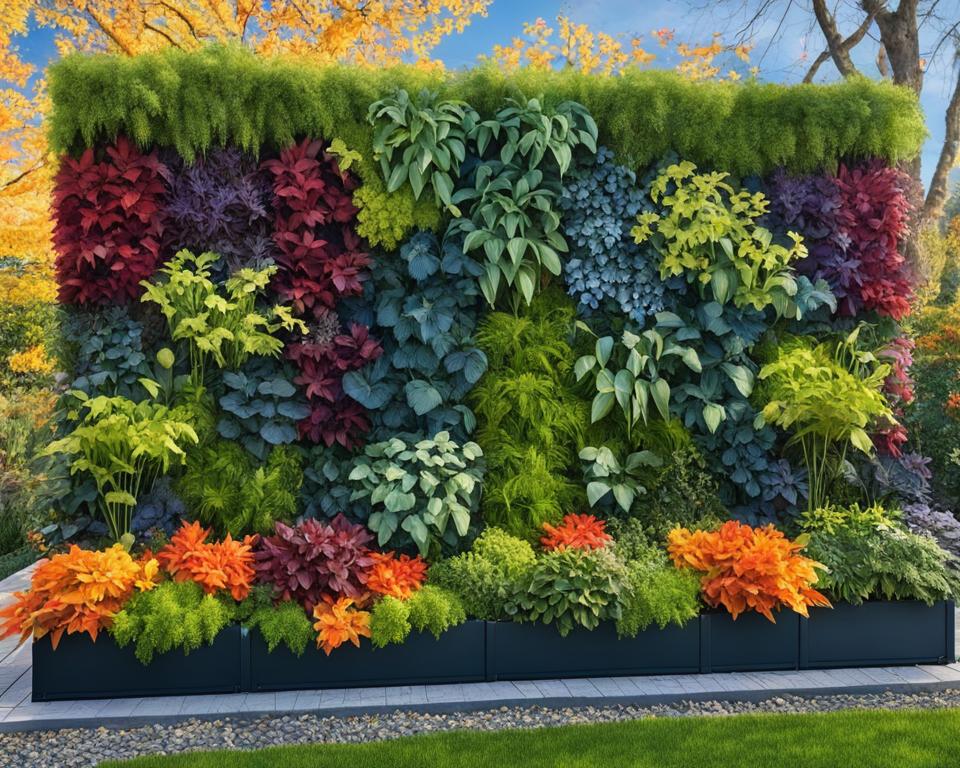
Embracing vertical gardening within the robust walls of a greenhouse means enjoying the perks of year-round gardening. Unlike traditional methods, exploiting the vertical dimension transcends the constraints of seasons, bringing about a horticultural revolution that guarantees your greens regardless of snow or sun outside.
Your passion for plant cultivation can now persevere through all seasons, thanks to the controlled climate of a greenhouse tailored for vertical growth. This strategic pairing empowers you to bypass the whims of weather with a consistent harvest cycle, ensuring a steady stream of produce to your table or market stand.
- Control temperature to protect against frost or heatwaves.
- Balance humidity levels to ward off plant diseases.
- Provide supplemental lighting during darker months.
Considering the varying needs of plants according to season, here’s how you can adapt your greenhouse to maintain optimal growth conditions all year long.
| Season | Temperature Control | Lighting Adjustment | Humidity Management |
|---|---|---|---|
| Spring | Increase venting during the day | Use natural light | Monitor for spring showers |
| Summer | Shade and cool to prevent overheating | Extend daylight with artificial lights | Increase airflow to reduce humidity |
| Fall | Employ heaters for frost prevention | Supplement shorter days with grow lights | Reduce ventilation to maintain warmth |
| Winter | Insulate and heat as necessary | Maximize light exposure, add UV lamps | Control humidity to avoid mold |
By refining these aspects season by season, your vertical garden will not only flourish but also turn into a sustainable source of joy and nutrition, proving year-round gardening to be a bountiful and rewarding endeavor.
Organic Practices in Vertical Greenhouse Gardening

Embracing organic methods in your vertical greenhouse is not just a trend—it is a commitment to sustainable gardening. Organic gardening practices are key to nurturing a thriving ecosystem and promoting biodiversity. The inclusion of natural processes and materials helps to create robust plant life without the reliance on synthetic chemicals.
Composting and Natural Pest Control
Implementing a composting system can transform organic waste into valuable, nutrient-rich compost, providing your plants with the fertilization they need to grow strong and healthy. Moreover, natural pest control strategies allow you to manage pests without resorting to harmful chemicals. Practices such as introducing beneficial insects that prey on pests or creating barriers with netting contribute to a balanced and productive garden.
Fostering Pollinator-Friendly Environments
In addition to pest management, supporting pollinators such as bees and butterflies is crucial. These pollinators facilitate the reproductive process of plants, leading to better yields and a more dynamic garden. You can foster pollinator-friendly habitats by including a variety of flowering plants and providing safe water sources, ensuring that your vertical oasis becomes a hub for these essential creatures.
Scaling Your Vertical Garden for Commercial Success
Embarking on the journey of scaling your vertical greenhouse gardening endeavor for commercial gardening success can be both exciting and daunting. But, with strategic planning and the incorporation of innovative technologies, you can expand your operation significantly. By optimizing space and resource management, your vertical garden can transform into a prolific and profitable business.
The versatility of a vertical garden setup means you are equipped to adapt swiftly to market demands without the need for large parcels of land. This not only saves on initial investment costs but also caters to the urban consumer’s desire for locally grown produce.
Consider expanding your vertical structures both in height and quantity. Adding more layers to your vertical farms can substantially increase your production capacity. Furthermore, introducing automated irrigation and nutrition systems can not only save time but also enhance efficiency and reduce waste, further lowering operational costs.
- Assess the scalability of your current system
- Explore innovative vertical farming technologies
- Automate processes for efficiency
- Analyze market trends for crop selection
- Implement data-driven farming for yield optimization
Data-driven cultivation is another vital strategy. By harnessing the power of data analytics, you can make informed decisions that can lead to improved crop quality and yield. Such insights can inform everything from climate control settings to harvest times, ensuring that every plant grown reaches its highest potential.
Remember, the path to commercial success in vertical greenhouse gardening involves a continuous process of learning and adaptation. By remaining flexible and open to new developments, you give your vertical garden the best chance to flourish in the commercial market.
Conclusion: Enhancing Your Greenhouse with Vertical Gardening
As we reach the culmination of our exploration into vertical greenhouse gardening, it’s clear that this innovative approach offers a plethora of advantages that cater to the pressing demands of modern agriculture. By embodying the essence of space efficiency, water conservation, and the ability to yield crops all year round, vertical gardening not only meets but also exceeds expectations in the realm of sustainable cultivation. For urban dwellers and green-thumbed visionaries, it provides a feasible solution to the growing space constraints brought on by urban development.
Summarizing the Benefits of Vertical Greenhouse Gardening
You’ve seen how adopting vertical gardening in your greenhouse not only bolsters your green space but also significantly diminishes your environmental footprint. This dynamic style of gardening amplifies the use of every square inch, providing an verdant oasis rich in diversity that thrives in a controlled, resource-conserving environment. With vertical greenhouse gardening, your efforts are rewarded with the bounty of fresh produce, regardless of the limitations typically imposed by traditional land farming methods.
Future Trends and Innovations
Looking to the horizon, the future trends in gardening are set to be shaped by vertical greenhouse gardening advancements. Pioneering technologies, sustainable materials, and smart farming methods are converging to redefine what’s possible in urban agriculture. As environmental sustainability becomes an ever-pressing concern, expect to see a wave of innovation that will make vertical gardening practices not only more efficient but increasingly commonplace. By staying informed and adaptable, you can fully harness the potential of vertical gardening to transform your greenhouse into a model for sustainable agriculture in your community.
FAQ
What is vertical greenhouse gardening?
Vertical greenhouse gardening is an innovative approach to cultivating plants in vertically stacked layers within a greenhouse. This method maximizes space efficiency, especially in urban areas, by using vertical surfaces and controlled greenhouse conditions to grow a variety of plants.
How does vertical gardening impact urban farming and sustainability?
Vertical gardening revolutionizes urban farming by utilizing limited space more efficiently and by offering a sustainable way to grow food locally. It reduces land use, water consumption, and the carbon footprint associated with food transportation.
What are some effective gardening hacks for small spaces?
To maximize small spaces, use vertical structures like trellises, shelves, or hanging baskets, and consider soilless growing methods like hydroponics which utilize water and nutrients more efficiently than traditional soil-based gardening.
How does a vertical garden help to reduce my carbon footprint?
A vertical garden reduces your carbon footprint by allowing you to grow produce locally, thus cutting down the distance food needs to travel from farm to table. It also optimizes the use of vertical space in urban environments, leading to less land disturbance and habitat loss.
Can vertical gardens conserve water?
Yes, vertical gardens can significantly conserve water through advanced irrigation techniques such as drip irrigation or closed-loop hydroponic systems, which recycle water and nutrients with minimal waste.
How does vertical greenhouse gardening create pesticide-free ecosystems?
The controlled environment of a vertical greenhouse reduces pest infestation, which in turn lowers or even eliminates the need for chemical pesticides. Many vertical gardens also use organic and natural pest control methods to maintain healthy plant life.
Which crops are best suited for vertical greenhouse gardening?
Herbs, leafy greens, strawberries, peas, tomatoes, and cucumbers are among the crops well-suited for vertical greenhouse gardening. They thrive in the increased airflow and light exposure that vertical systems provide.
What should I consider when selecting materials for my vertical garden structure?
Choose materials that are durable to support the weight of plants and resistant to weather conditions and potential pests. Also, consider materials that contribute positively to the garden’s aesthetics and plant health, like those allowing for proper light and air circulation.
How do hydroponic, aquaponic, and aeroponic systems differ?
Hydroponic systems grow plants in a nutrient solution without soil, aquaponic systems combine fish farming with hydroponics for a symbiotic environment, and aeroponic systems use mist to deliver nutrients to plants’ roots suspended in the air.
Can vertical gardens be productive throughout different seasons?
Yes, the controlled conditions within a greenhouse allow for vertical gardens to remain productive throughout all seasons, regardless of the weather outside, ensuring a consistent and year-round supply of produce.
How do organic practices enhance vertical greenhouse gardening?
Organic practices like composting, natural pest control, and promoting pollinator-friendly environments enrich soil and plant health, reduce chemical use, and ensure sustainable productivity of the vertical greenhouse garden.
What are strategies for scaling a vertical greenhouse garden commercially?
Commercial scaling strategies may include implementing more advanced vertical structures, automating watering and feeding systems, and using data-driven approaches to optimize plant growth and reduce operational costs.
What are some future trends and innovations in vertical greenhouse gardening?
Future trends may involve advanced technologies like AI for monitoring plant health, improved hydroponic and aeroponic systems, more efficient lighting solutions such as LED grow lights, and new sustainable materials for building vertical garden structures.

